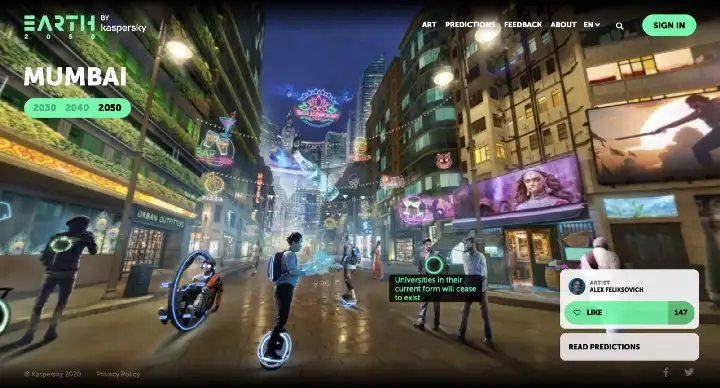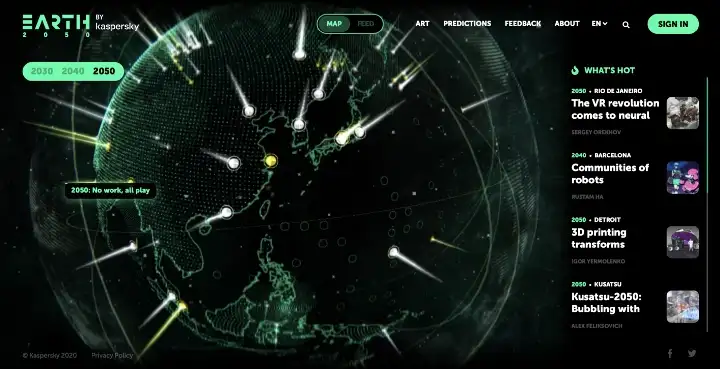Start your day with intelligence. Get The OODA Daily Pulse.
Start your day with intelligence. Get The OODA Daily Pulse.
Featured Image Source: DeMagSign
“From cities and transport to food and wearables, design fiction spawns projects that are not only food for our dreams but also an incentive for a better future.”
Speculative Design: “a design practice that is concerned with future design proposals of a critical nature. The term “speculative design” was popularised by Anthony Dunne and Fiona Raby as a subsidiary of critical design. The aim is not to present commercially driven design proposals but to design proposals that identify and debate crucial issues that might happen in the future. Speculative design is concerned with future consequences and implications of the relationship between science, technology, and humans. It problematizes this relation by proposing provocative future design scenarios where technology and design implications are accentuated. These provocative design proposals are meant to trigger the debate about future challenges. Speculative design proposals might seem subversive and irreverent in nature as they are meant to initiate discussions not to be market products.” (1). For more, see the work of Syd Mead.
As the 27th Conference of the Parties to the United Nations Framework Convention on Climate Change (COP27) meets in Sharm el-Sheikh, Egypt, we dedicate this installment of the Speculative Design Series to the future of the planet.
Giorgia Lombardo is the Editor of DeMagSign and Head of Brand & Comms at Design Matters. Earth 2050 was included in Lombardo’s 2020 post on Medium about 8 Spectacular Speculative Designs That Will Blow Your Mind. Lombardo’s description of speculative design is eloquent and complements the aforementioned working definition we use for this series:
“From cities and transport to food and wearables, design fiction spawns projects that are not only food for our dreams but also an incentive for a better future. Here, we cherry-picked some of the most vivid and beautiful examples of speculative design. Speculative Design is one of the most exciting ways for designers to practice problem-solving by design. Using Design Thinking and other methods, we can broaden our scope and develop boundary-pushing systems and prototypes that spur discussion about alternative ways of being and encourage imagination to flow freely. Design speculations have the potential to become the catalysts for redefining our relationship to reality and cultures; the results are truly inspiring, with a seductive vividness and a promise of a far future that is not far from science fiction stories.” (1)
Take a step into the future of the planet @ Kapersky’s Earth 2050.

What Mumbai might look like in 2050. From Earth 2050
Earth 2050 [is] a site about the future as seen through the eyes of futurologists, scientists, and Internet users from all corners of the globe. Select a year — 2030, 2040, or 2050 — and study the predictions for different cities and countries: what will happen to our planet, what our lives will be like, what jobs we will have, what we will eat, and more. Got anything to add? Vote, comment, and make your own predictions.
This project was created and is supported by Kaspersky, which for more than 20 years has been developing innovative solutions to protect critical infrastructure and cities, businesses, and ordinary users. We at Kaspersky try to make the world a safer place. To do this, it’s important to have a mental picture of what we can expect in the future: how people will live in 20 or 30 years’ time, what needs to be protected, what threats will exist, and how the physical world will interact with the virtual. Therefore, we are looking for a variety of opinions — from experts, futurologists, and simply anyone who cares about the future.
The more we consider the likely trajectories of society and technology, the more we can foresee — and thus make our common future better and more secure.

Map with predictions for 2050. From Earth 2050
David Brin is an American scientist, world-known sci-fi author, speaker, and technical consultant. His novel The Postman was adapted as a feature film and starred Kevin Costner in 1997.
Rabat, Morocco – 2050
In 2030, all phosphate reserves used for agricultural fertilization in the world are running out. The phosphate crisis is worse than the oil crises of the 20th century. Iraq and Algeria, large players in the phosphate market, drastically reduce their mining in an attempt to control prices. The world is on the verge of famine. Enter Morocco, which has the largest phosphorus deposits. This is how the African country becomes one of the richest countries in the world.
The capital of Morocco, ancient Rabat, becomes one of the most technologically advanced cities in the world. More than a million technological experts from old Europe move here. They live and work in arcology towers where they grow much of their own food along south-facing gardens.
The Moroccan government, Elon Musk, and large investment companies from Moscow have created a consortium — “Musk-Muscovy” — that focuses on searching for new deposits of phosphate and other rare materials on the bottom of the ocean. The first underwater town, Jacques-Yves, is built in 2040. It is named after Jacques-Yves Cousteau — the first human to live for an extended period underwater. Jacques-Yves’ first settlers are adventurers: deep-water miners, scientists, and engineers. 476 new Atlanteans believe that they will save humankind from starvation.
First attempts at ocean mining show that it will have certain ecological risks and will be quite costly. An overview of potential threats makes scientists limit any operations to only those areas currently being mined. This means humanity must look for new sources of phosphate. The next possible sources attracting attention are asteroids. First expeditions confirm that mineral deposits there exceed all expectations. Promising asteroids can be moved into orbits that provide both accessibility and stability.
Robots have been harvesting water from asteroids for some years, but for other elements, a human presence will be needed. Construction of the first space base, Odyssey, is completed in 2049. It is located below the surface of a phosphorus-rich asteroid, which helps it avoid temperature drops and magnetic storms. Astronaut-geologists work there in rotations. Soon, asteroids are providing not only water, and then gold, silver, platinum, and rare-earth elements, but also the phosphates giving new hope to billions.
On Earth Day 2050, April 22, the UN General Assembly adopts resolution Z/RES/22/2050, stating that all damaging geological development of the Earth, such as mining and pollution-producing refining should cease within the next decade. As space resources become plentiful, the mining of planetary minerals should decrease, and profits from space deposits should be used to restore and preserve the ecological balance of the planet, turning it into a beautiful blooming garden.
Earth 2050 has two main pages, arranged differently. The Map loads by default on desktop computers, and the less-demanding Feed appears on smartphones and tablets. There’s a Map–Feed toggle in the middle of the screen.
Circles on the Map indicate places where someone has left a prediction. If the circle is white, predictions about the place are text-only; if yellow, the predictions include illustrations.
Many of the illustrations are 360-degree panoramas that reveal more details when rotated. They too have circles on them with predictions and additional images. The toggle in the upper left corner lets you travel through time — to 2030, 2040, and 2050. You can use this feature to see how a particular place will change over the years.
The Feed has all this too, but is organized slightly differently. It’s great for watching the latest news or viewing predictions on a specific topic.
Agree with a prediction? Vote for it. Don’t agree? Click No. You can also leave comments under each prediction. Lively discussions are raging right now under many.
We invite everyone to speak up and offer their vision of the future. To leave a prediction, you need to log into your profile and click your avatar followed by the Add prediction button (or just click here). Next, you need to indicate the place about which you want to make a prediction, choose a year, write your forecast, and post it. After approval by the moderators, it will appear on the site.
This is a long-term project, and we can’t do it all at once. But we will try to fill in the blanks. Suggest your vision of the future of your hometown, street, or favorite place on Earth. Add a prediction and this place will appear on the map.
Many renowned futurologists and experts in specific areas are involved in the project.
Our authors include British futurologist Ian Pearson, US science fiction writer David Brin, British cosmologist and astrophysicist Martin Rees, angel investor Steve Hoffman, popular blogger Isaac Arthur, architect and engineer Carlo Ratti, and many other top-notch professionals. Many predictions came from Kaspersky’s own experts.
The illustrations were created by professional artists and concept designers from around the world.
We welcome everyone’s ideas. But only those that pass our editorial filter will get published. We’re sure you understand that only high-quality content can be allowed onto the site.
Sure we will. But the future is not a stiff monolith; it’s a motley mosaic of many concepts and ideas. We all have different backgrounds and perspectives, and so of course ideas and predictions will differ slightly from place to place.
Some older devices do not support WebGL technology, which is used in Map mode. Try the Feed instead.
Thank you for noticing. Please write to us with the subject line “Mistake” and we’ll fix it.
Sure! Feel free to share content from this website — just be sure to cite the source and the author.
© Kaspersky 2022 Privacy Policy
The OODA Loop Speculative Design Series
It should go without saying that tracking threats are critical to inform your actions. This includes reading our OODA Daily Pulse, which will give you insights into the nature of the threat and risks to business operations.
Use OODA Loop to improve your decision-making in any competitive endeavor. Explore OODA Loop
The greatest determinant of your success will be the quality of your decisions. We examine frameworks for understanding and reducing risk while enabling opportunities. Topics include Black Swans, Gray Rhinos, Foresight, Strategy, Strategies, Business Intelligence, and Intelligent Enterprises. Leadership in the modern age is also a key topic in this domain. Explore Decision Intelligence
We track the rapidly changing world of technology with a focus on what leaders need to know to improve decision-making. The future of tech is being created now and we provide insights that enable optimized action based on the future of tech. We provide deep insights into Artificial Intelligence, Machine Learning, Cloud Computing, Quantum Computing, Security Technology, and Space Technology. Explore Disruptive/Exponential Tech
Security and resiliency topics include geopolitical and cyber risk, cyber conflict, cyber diplomacy, cybersecurity, nation-state conflict, non-nation-state conflict, global health, international crime, supply chain, and terrorism. Explore Security and Resiliency